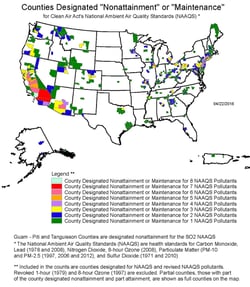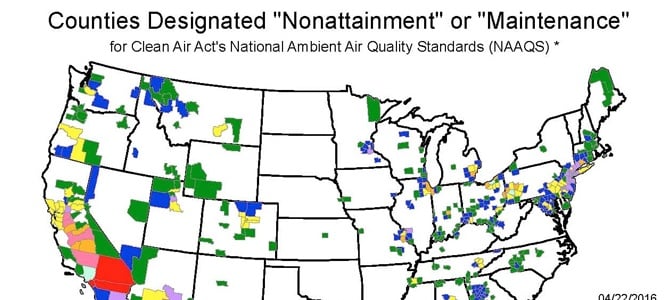Air quality regulation starts with National Ambient Air Quality Standards, more commonly known by the abbreviation NAAQS. The NAAQS represent the maximum concentration of each regulated pollutant that can be present in the air we breathe, according to the Environmental Protection Agency (EPA). Each maximum concentration is chosen to fulfill the EPA’s mandate to protect human health and the environment.
Considered another way, the NAAQS represent a tripwire. If a particular area exceeds the NAAQS for a particular pollutant, then the local permitting authority (usually a state agency, but some states have multiple smaller permitting authorities) must come up with a plan to reduce the amount of the pollutant in the air to a level below the NAAQS. The plan must be submitted to and approved by the EPA.
If the air in an area meets the NAAQS for a particular pollutant, it is said to be “in attainment with the NAAQS” for that pollutant, although one of two shorthand versions of that phrase are more commonly used: the area is “in attainment”, or it’s referred to as “an attainment area.”
If the air in an area does not meet the NAAQS for a particular pollutant, it is said to be “in non-attainment with the NAAQS,” or more commonly, it’s called a “non-attainment area.”
 Attainment and non-attainment designations are pollutant specific. This means that an area can be in non-attainment for sulfur dioxide, but in attainment for nitrogen dioxide, or vice versa. Any combination is possible with respect to the NAAQS for the “big six” criteria pollutants: particulate matter, nitrogen dioxide, sulfur dioxide, carbon monoxide, ozone, and lead.
Attainment and non-attainment designations are pollutant specific. This means that an area can be in non-attainment for sulfur dioxide, but in attainment for nitrogen dioxide, or vice versa. Any combination is possible with respect to the NAAQS for the “big six” criteria pollutants: particulate matter, nitrogen dioxide, sulfur dioxide, carbon monoxide, ozone, and lead.
Attainment status usually applies to a county, but it can occasionally apply at the township level. In urban areas, adjoining counties in non-attainment are regulated as group and referred to as a “Metropolitan Statistical Area” or “MSA.” The Chicagoland MSA, for example, is designated non-attainment with respect to the ozone NAAQS, and regulations to address it apply to six adjoining counties in the Chicago area, along with two neighboring counties in Indiana and one in Wisconsin.
Counties and MSAs can and do bounce back and forth between attainment and non-attainment status. This almost never reflects increases in emissions, but rather reductions in the NAAQS for a particular pollutant. For example, the original 120 parts per billion (ppb) ozone standard has been lowered twice: to 80 ppb during the Clinton administration and to the current 75 ppb standard during the George W. Bush administration. The Obama administration has floated proposals to lower it further to 65 or 70 ppb.
The averaging period can also make a difference in attainment status. In the above example, the 120 ppb standard was based on one hour average readings taken by ambient monitors that dot the nation. The subsequent 80 ppb and 75 ppb standards are based on eight hour averages. In the last few years, very stringent one-hour standards for fine particulate matter and nitrogen dioxide were put in place by the EPA, resulting in more non-attainment areas for those pollutants than under the older, less stringent standards that were based on longer averaging periods.
Non-attainment areas matter because additional and more stringent regulations will apply to facilities that emit pollutants deemed to contribute to non-attainment, and industrial sources are often targeted before any other type of source. This is true whether or not industrial sources are a big contributor when compared to other types of sources. For example, in most urban areas, industrial sources will emit much less Volatile Organic Compounds (VOCs – a precursor to ozone formation) as a whole than vehicular traffic as a whole. However, since it is easier to require additional controls from a few hundred factories than it is to regulate a few million cars and trucks, industry does the brunt of the work when the non-attainment area is created.
Here's where you can access our eBook "EPA Ozone Standards".









